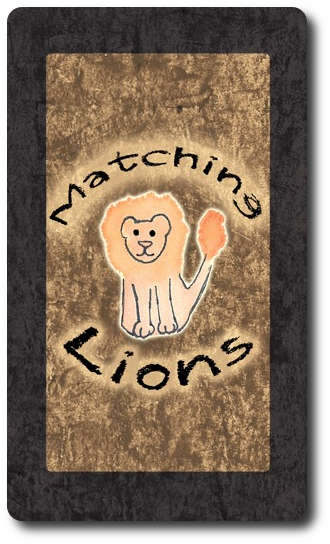
The Basics:
- For ages 3 and up
- For 2 to 6 players
- Approximately 20 minutes to complete
Geeks Skills:
- Active Listening & Communication
- Counting & Math
- Logical & Critical Decision Making
- Risk vs. Reward
- Hand/Resource Management
Learning Curve:
- Child – Easy
- Adult – Easy
Theme & Narrative:
- Be the first to safely gather a herd of animals to win, but do it fast before the hungry lions arrive!
Endorsements:
- Gamer Geek rejected!
- Parent Geek approved!
- Child Geek approved!
Overview
The African Savanna is teaming with life. Large herds of animals wander from one watering hole to the next and prides of lions rest on rocks or hunt in the tall grass. Every animal has its place in the wide open space and every animal has a purpose. Some eat the grass and some eat the grass eaters. And then there is the hyena, who is the “jerk” of the wild. But even the hyena has a role to play, as do the players of this game.
Matching Lions, a self-published game designed by Sonya Writes and Acacia Justice , is comprised of 84 cards that represent a menagerie of 7 different wild animal types. Specifically, antelope, zebras, lions, hippopotamuses, elephants, giraffes, and hyenas. The cards are slightly longer than they are wide, making them easy for little hands to grab and the artwork is done in a style that is very reminiscent of a second grader’s art project. Which is to say, they are cute and colorful. There is no writing on the cards other than the name of the animal the illustration is representing.
Game Set Up
To set up the game, fist take the 84 cards and give them a really good shuffle.
Second, deal out to each player 5 cards, face-down. Players should look at their cards and keep them hidden from their opponents at all times. If any player is dealt a hyena, it should be replaced by a new card and then shuffled back into the deck.
Third, place the deck of cards face-down in the middle of the playing area. Leave room for a discard pile.
That’s it for game set up! Let’s play!
Herding Wildlife
The game is played in turns with no set number of rounds. On a player’s turn, they will complete 3 steps which are summarized here.
Step 1: Draw a Card
The player’s first action is to draw a card from the deck. If the card is any animal other than the hyena, it is added to the player’s hand and the player continues to step 2. If the card is the hyena, the card is immediately revealed and placed on the discard pile. Any “herd animals” (explained below) that are in front of the players now migrate to the left. In other words, if one player had 3 “herd animals” in front of them, all 3 would be given to their opponent directly to their left (clockwise). The player now continues to step 2.
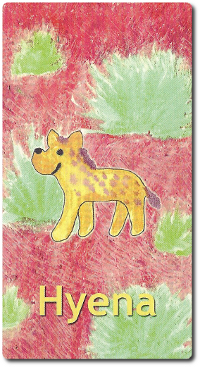
Players get to draw another card if they draw the hyena. If the deck of cards ever runs out, simply shuffle the discard pile and place it face down to create the new draw deck.
Step 2: Play 1 Herd Animal
The player’s second action allows them to play a “herd animal”. The “herd animals” are the antelope and the zebras. Players can only play 1 of either type in front of them on their turn, face-up. For example, the player could place 1 antelope or 1 zebra in front of them, not one of each or two of the same kind. If there is already a “herd animal” of the same type in front of the player, it is added to the face-up pile. If not, a new face-up pile is created. Note that a player is never required to play a “herd animal” if they do not want to.
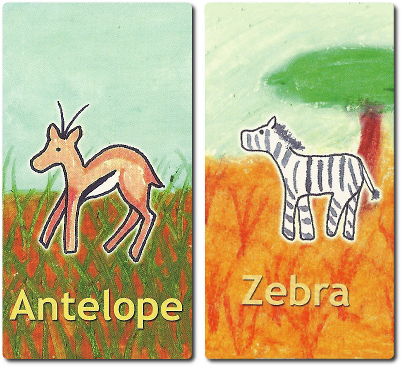
Step 3: Play Lions, Giraffes, or Elephants
The player’s third action allows them to play either 1 lion, 1 giraffe, or 1 elephant out in front of them, face-up.
- When the player has a pair of lions, they can discard the matching lions to remove 2 “herd animals” visible in front of another player. These can be 2 of the same type or one of each. Chased away “herd animals” are placed in the discard pile along with the matching lions. Players can have multiple pairs of lions in play at any time and are not required to use them once a matching lion pair is available. For example, if the player had 3 pairs of lions, they could target 6 “herd animals” owned by a single opponent or split them among multiple opponents. Note that a player need not have just played a lion to trigger any currently visible matching lion pairs during this step.
- When the player plays a giraffe, they get to look at the cards held by one player. The giraffe is then discarded.
- When the player plays an elephant, all lions currently visible are returned to their owner’s hand (including the player who just played the elephant). The elephant is then discarded.
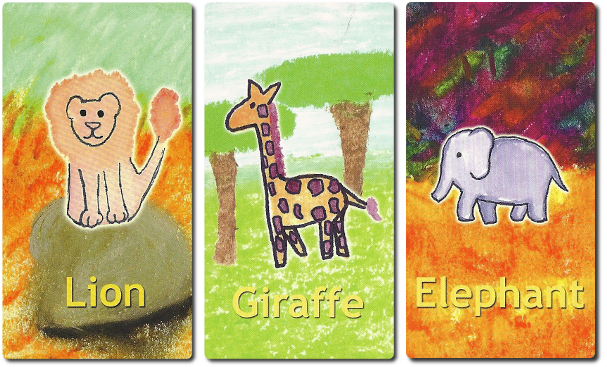
Conditional Cards and Play
- If a player ever plays all their cards in their hand, they draw 5 more cards form the draw deck.
- The hippopotamus is a defense card that can be played when the player’s “herd animals” are being attacked by lions. The hippopotamus will foil a matching lions’ hunt and send them to the discard pile, along with the hippopotamus.
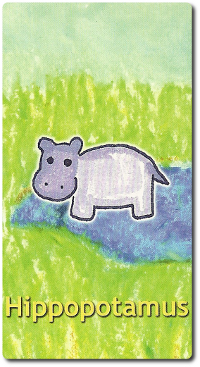
This concludes the player’s turn. The next player going clockwise now goes starting with step 1 above.
Winning the Game
The game continues until one player has 5 cards of the same “herd animal”. For example, 5 antelope or 5 zebras. The first player to have such a collection wins the game!
To learn more about Matching Lions, see the game’s web page.
Prediction
Matching Lions is by no means a “complicated” game, but it’s not a walk in the park..err…African Savanna, either. Players can only play 1 “herd animal” per turn and then only one other animal to address anything their opponents are doing. They can also build up their army of lions as both a threat to others or simply keep them out there as a bluff. But even those lions are not safe from a rampaging elephant and all the “herd animals” will quickly scatter if the irritating hyena should suddenly appear. This makes the game something more than a simple exercise of laying down cards. Players must “think” through their moves and consider the timing in which the cards are played. I love the idea that I can build up my lions to take on larger groups of “herd animals” but I could lose them if the elephant suddenly appears. This forces me to consider when to use them as well as on who. A neat way to introduce a light risk versus reward game mechanism.
I predict the game will do very well with the Child Geeks, but I don’t think Child Geeks younger than 4 will be able to play it well. The game age range suggests players as young as 3, which might be totally possible, but I know my 3-year-old won’t be able to keep track of the different actions in his head. Which makes me pause and consider how long it will take the Child Geeks to learn what each animal can do. There is nothing on the cards to suggest what the card should be used for, which irritates me. A nondescript card in a card game doesn’t mean it’s a bad card or game, mind you. It just means that the players are tethered to the game rules and must constantly go back and refer to them until such time they memorize what each card can do. Luckily, there are very few cards and the actions each card provides makes sense as it relates to the animal type. Still, I’m sure I’ll be calling out actions throughout the entire game until such time my Child Geeks tell me to stop.
For the Parent Geeks, I think they will approve of Matching Lions. The game rules are light and the game play would appear to be engaging enough to keep all the players involved, but the overall game play length short enough to not bore anyone. At a peer level, I doubt Matching Lions will be of much interest to the Parent Geeks, but as a family game, I’m sure it will do very well.
Gamer Geeks will respect what the game is attempting to do, at the most. The Gamer Geeks abhor games that are “dumbed down” for kids. According to one Gamer Geek, “kids aren’t dumb so don’t put dumb things in front of them.” I totally agree. Games that are too simple are no fun for anyone. Kids like to be challenged, to a point. Put something in front of them that is too easy and they’ll quickly lose interest. Too difficult and they’ll crumble. Matching Lions would appear to be a good balance between easy game play and thoughtful game play. While excellent for the Parent and Child Geeks, Matching Lions is not nearly deep or strategic enough to register on a Gamer Geek’s radar.
Teaching the game is simple and quick, but do expect to remind players what they need to do, what card types they need to play, and what each card’s actions are. This simply cannot be avoided. If the cards had some sort of text on them that described what they do, the individual player could figure it out themselves. Even a small player’s aid would help out, but since there is none, at least one player (and usually the one teaching the game) needs to call out the turn order and steps until such time everyone at the table knows what they are doing. Shouldnt’ take long, though. Matching Lions is not an overly complicated game, but it is fast. Perhaps a bit too fast for the younger and less experienced player to catch on. All you can do is take your time and be patient, which comes as second nature to a Parent Geek.
When I taught my Child Geeks the game, my 5 and 8-year-old had no problem understanding how the game was played and what the goal was. The same could not be said for my 3-year-old. He could identify all the animals (thank you, Ranger Rick), but couldn’t recall the steps or what the animals did. We resolved this by simply letting him be on a “team”, which is always a great way to include the younger Child Geeks at the gaming table. As my 8-year-old shuffled the deck of cards, I asked each of my Child Geeks what they thought of the game so far.
“Simple and straight forward. Should be fun for a little while.” ~ Liam (age 8)
“I like it, Daddy. I like how I can block your lions with my hippo’s fat butt!” ~ Nyhus (age 5)
“Lions go ROOOOOOOOOAAAAAAAAAAAAARRRRRR!” ~ Ronan (age 3)
Looks like all three of my Child Geeks are ready to go! Let’s play Matching Lions and see if the game amuses them as much as my little geeks amuse me.
Final Word
The Child Geeks enjoyed themselves while playing Matching Lions, but there is most certainly an age range that the game seems to really delight. Child Geeks as young as 3 can play this game (we did it, so can you), but they need a lot of hand holding and nudging. I suggest you play as a “team” at first until they get the hang of it and demonstrate interest in playing the game by themselves. The real “sweet spot” seems to be Child Geeks in the age range of 4 to 7 years of age. All our Child Geeks who were younger than 4-years-old didn’t demonstrate a solid understanding of the game and all the Child Geeks older than 7-years-old thought the game was too simple.
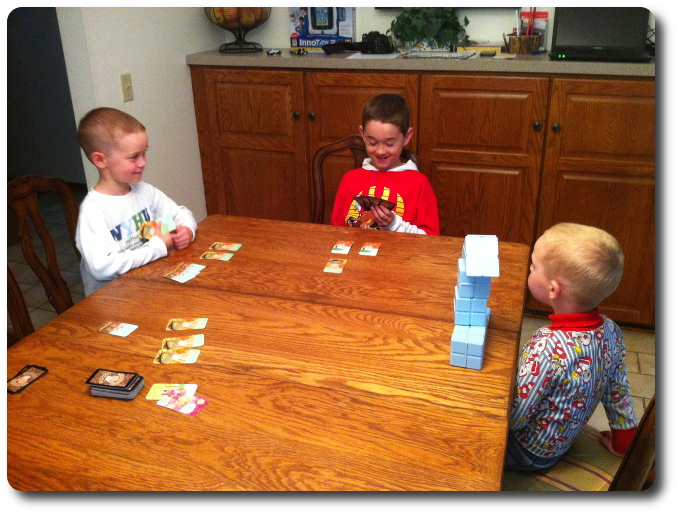
Playing the game with my two oldest while my youngest entertains himself with a puzzle
The Parent Geeks thought Matching Lions was a delightful family card game. At first, they found it very irritating that none of the cards had any text on them to suggest how they could be used, but quickly discovered that the game rules and game play were simple enough to easily learn and to memorize. All the adults who played the game got into the habit of saying, “OK. Draw a card. Is it a hyena? No? Then play 1 herd animal. OK, now play a giraffe, lion, or elephant. Now, do you want to chase away any animals with your lions?” This was asked again and again until all the Child Geeks knew the routine by heart and asked their Parent Geeks to “please stop”. As a family game, the Parent Geeks very much enjoyed Matching Lions, but it should come as no surprise that Matching Lions was not considered much of a Parent Geek game when played at a peer level. Clearly, this is not a game to be played by adults with only adults at the table. According to one Parent Geek, “I really like this game for my kids. It’s simple, fun, makes them think, and best of all, is a game I enjoy playing with them.” All the Parent Geeks agreed that Matching Lions was a worthy game to endorse and approve.
The Gamer Geeks didn’t care for the game, obviously. They reviewed the rules, let me teach them the game, and even played the game all the way through. They didn’t have anything negative to say about Matching Lions and thought it was a “pretty good card game for young kids.” But that’s not nearly enough for their endorsement. Still, having the Gamer Geeks at least suggest that the game was worth playing (albeit only by kids) is as about as good as you can possibly hope for from the gaming elitists.
At first, Matching Lions really annoyed me. The game comes with very little rules, but the cards have specific actions. These actions are not noted on the cards and there is nothing included in the illustrations that would suggest what an animal might or might not be able to do for the player. I thought this would make the game playing experience a bit painful as I constantly reminded players what certain animals did.Turned out that this was the case for only about 2 or 3 minutes of game play. Matching Lions has a 4:2:1 ratio of “herd animals” to the lions and the lions to the hippos. Not only did it accommodate the attention span of the Child Geeks (as the rules suggest), but it also served to make keeping track of the different actions the cards provided a snap. I still called out the actions, but I did that more out of habit than out of necessity. After only 1 game, my 5 and 8-year-old knew exactly what the cards did.
As a Parent Geek, I like Matching Lions. It’s a simple little card game that requires the player to make meaningful choices. Card timing is important, as is watching the table and opponents. The game serves to introduces more complicated game mechanisms without complicating or mucking up the experience. This gives the game just enough depth to keep things interesting from start to finish. As a Gamer Geek, I don’t think much of Matching Lions, but I’ll be the first to come to its defense. This is not a game meant for adults, but it is most certainly a perfect game for Parent and Child Geeks to play together. The game can be just as surprising and fun as it can be irritating. Just you wait until that hyena suddenly pops up and causes your almost complete herd of animals to suddenly migrate to your smiling 5-year-old who wins the game on their next turn! Excellent stuff and Matching Lions will certainly be a fun game to play at my table until my younger Child Geeks are ready for more complicated and involved games. Until then, Matching Lions is a fine use of their time and mine.
This game was given to Father Geek as a review copy. Father Geek was not paid, bribed, wined, dined, or threatened in vain hopes of influencing this review. Such is the statuesque and legendary integrity of Father Geek.



